Hobbyists looking for a fish with a lot of color and flare should consider a betta fish. Colorful bettas are the showpieces of many freshwater tanks in the aquarium hobby. There are over 14 colors of betta fish. They’ve gone through selective breeding for brighter colors.
Wild bettas have short fins and muted colors to help them blend in and avoid predators. Domestic bettas come in various notable colors — pale, dark, bright, and mixes.
A marble betta is one of the most colorful betta fish in the hobby. Dragonscale bettas have iridescent, shimmering colors. Pastel bettas are opaque and more muted.
As breeders cross different kinds of bettas, we’ll likely see more combinations.
10 Common Types of Betta Fish Colors
There are ten common types of betta colors, like red, blue, and yellow.
Bettas have pigment-bearing cells called chromatophores. The cells only contain three types of pigments: red, yellow, and black. These three colors combine in various ways to get the many colors and patterns we see in betta fish.
Red Bettas
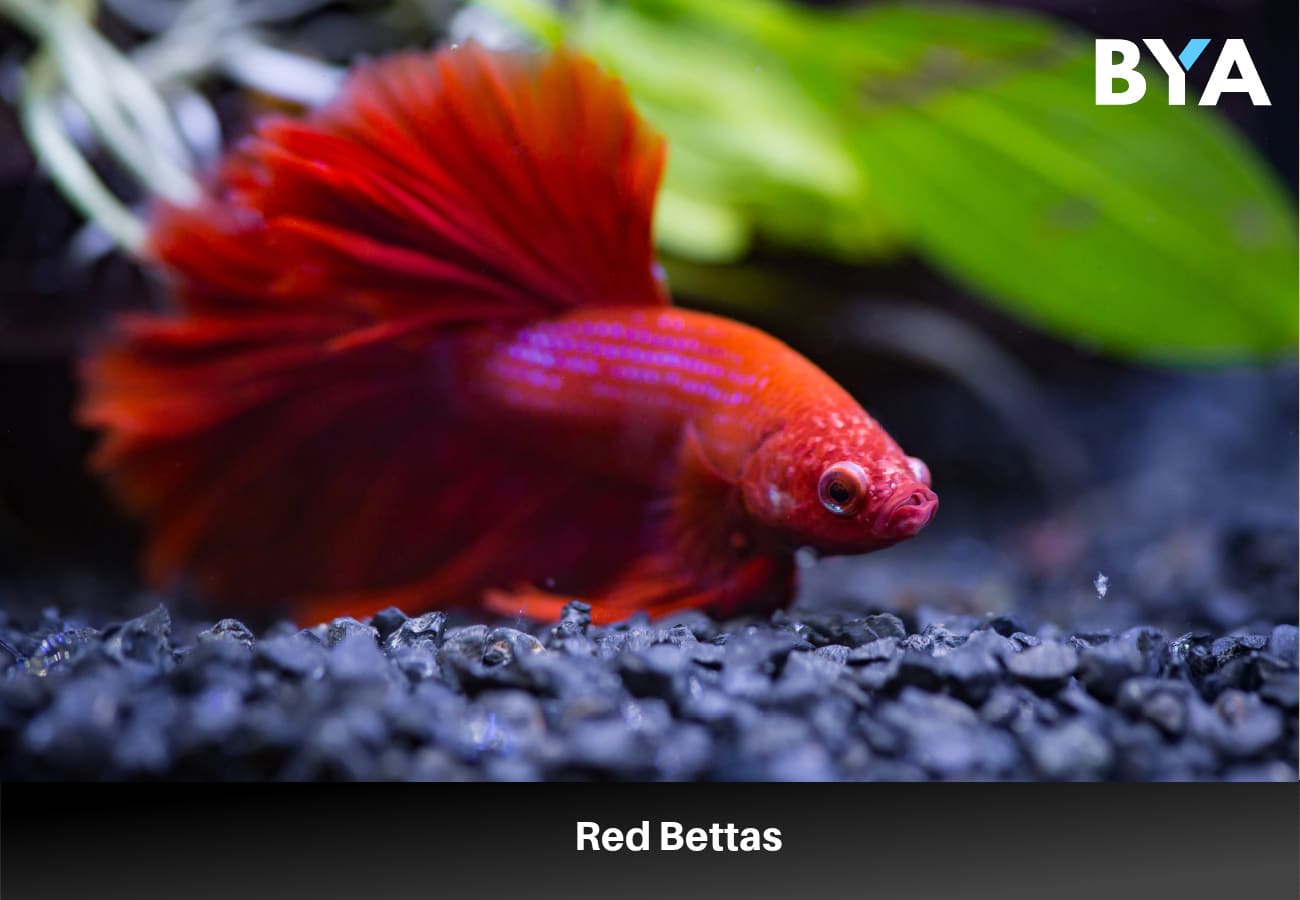
Bettas with red bodies are the most common because red is a dominant gene. Most red bettas are bright and solid in color. Those with a more washed-out red coloration are less popular.
Blue Bettas
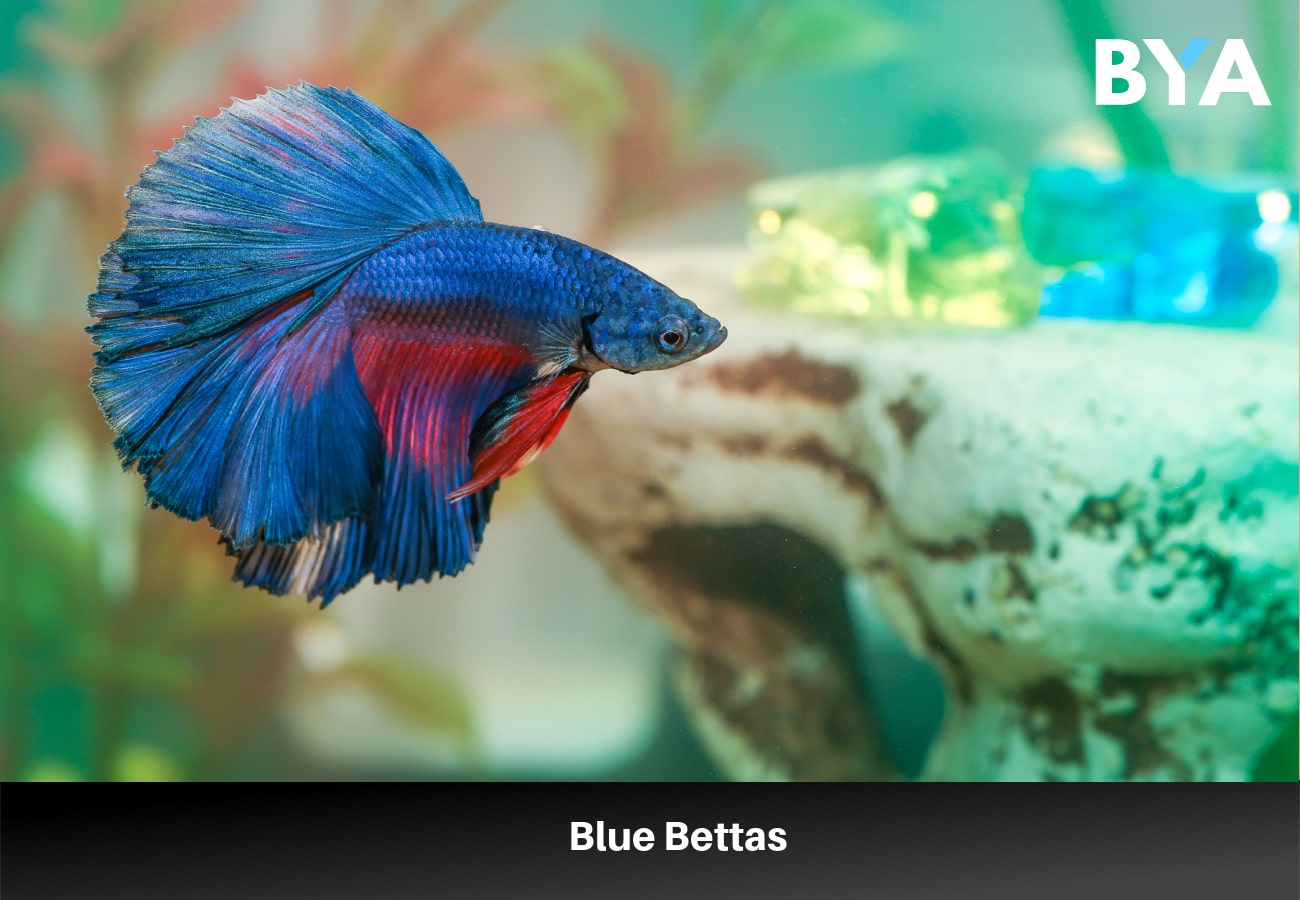
Blue is one of the most common colors seen in bettas. The fish can come in all different shades of blue; some are dark, light, iridescent, or bold.
The most common type of blue betta is the “true” blue or “blue wash” betta.
The “Royal Blue Betta” is the most popular because of its deep, shiny coloring. These are much harder to find than blue-wash bettas.
Turquoise Bettas
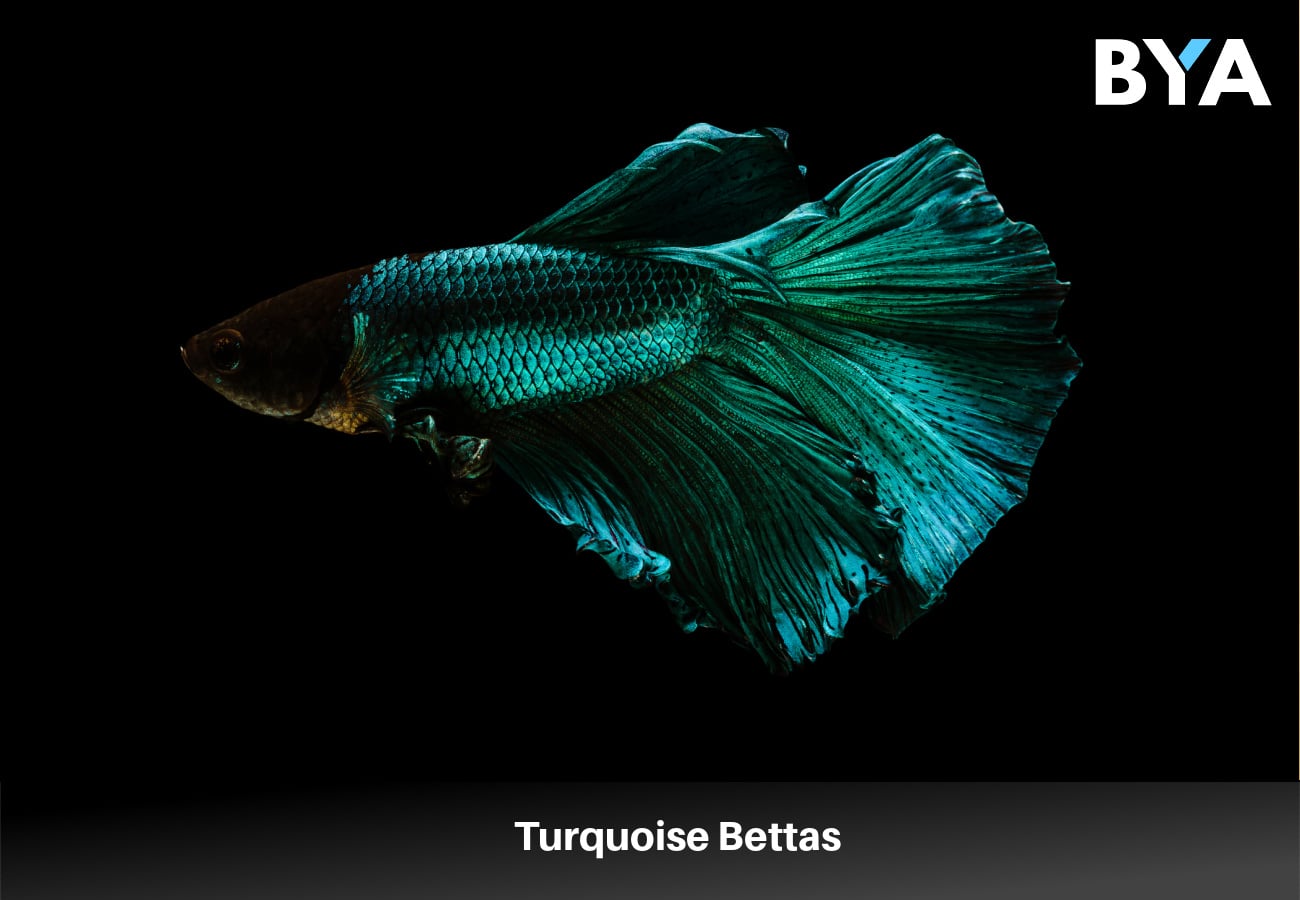
These bluish-green bettas are famous for their bright, shiny colors. Their bodies stand out best under bright light. Weaker lighting gives them more of a plain blue appearance.
Black Bettas
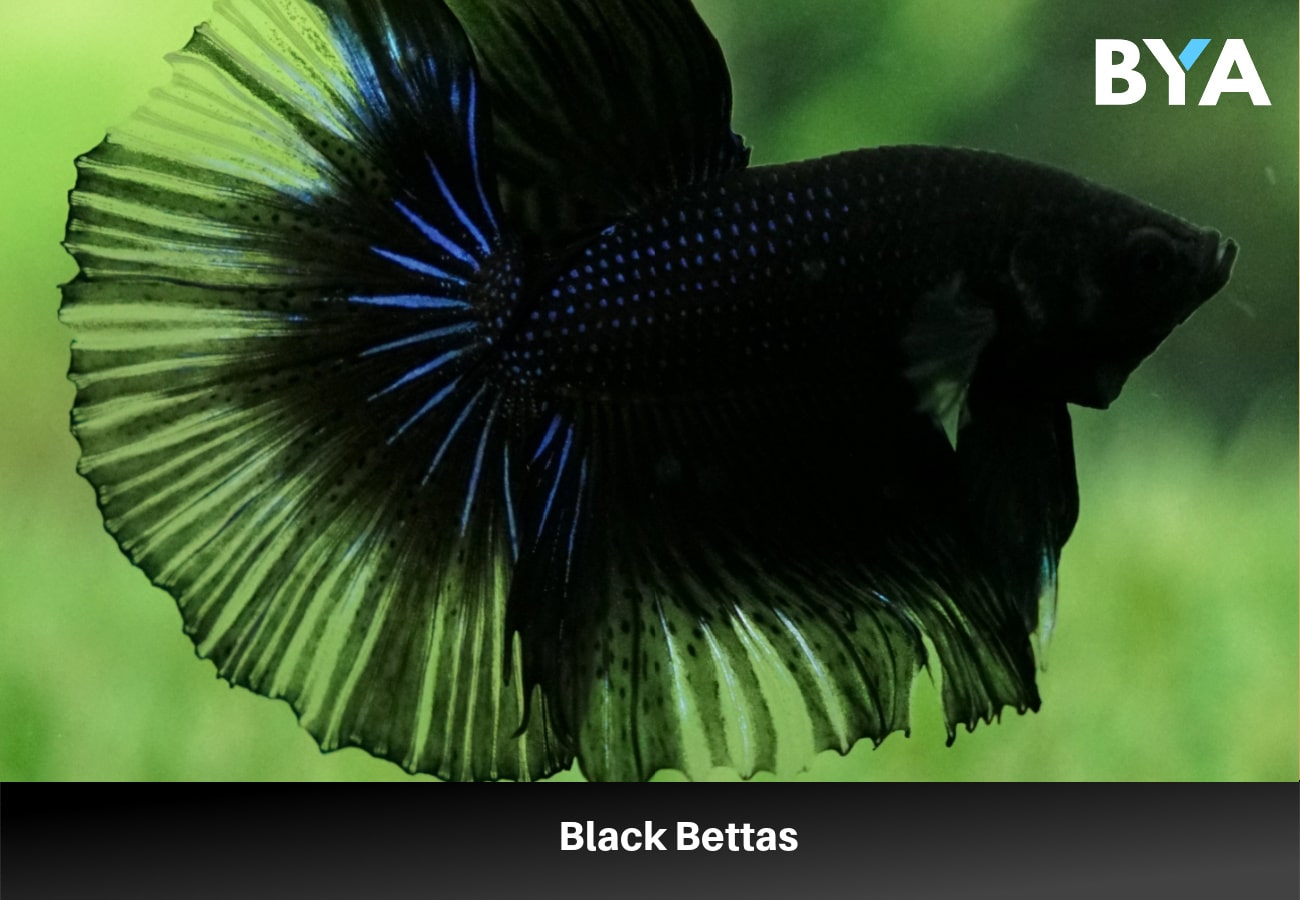
Bettas with black bodies are popular for their elegant, sleek looks. There are several different kinds of black bettas on the market.
Melano Bettas
Melano bettas have black skin due to a gene mutation. The mutation causes excess black pigmentation in the skin. They have the deepest black coloration of any black betta.
Melano bettas tend to be the rarest, though the most popular kind of black betta.
The mutation causes these fish to be infertile. To get a Melano betta, breeders must use a female who carries the gene but doesn’t exhibit the gene herself.
Black Lace Bettas
Black lace bettas have slightly lighter skin than Melano bettas. The edges of their fins are typically translucent, giving them a lacy appearance.
They are easier to breed because their coloration doesn’t cause infertility.
Black Orchid Bettas
Black orchid bettas are generally related to marble bettas and come in many fin types.
Their bodies are dark black, and their fins have streaks of iridescent blue. The patterning of the blue streaks gives them a similar look to butterfly bettas.
Black Devil Bettas
Black devil bettas are marbles that are similar to black orchids. Rather than having blue in their fins, they have red streaks.
It’s tough to breed these bettas, and they simply seem to appear by luck.
Black Ice Bettas
Black ice bettas also have the marbling gene. Their fins and bodies have green, gray-blue, or royal blue iridescent streaks. The intensity of their black color varies significantly from fish to fish.
Cellophane Bettas
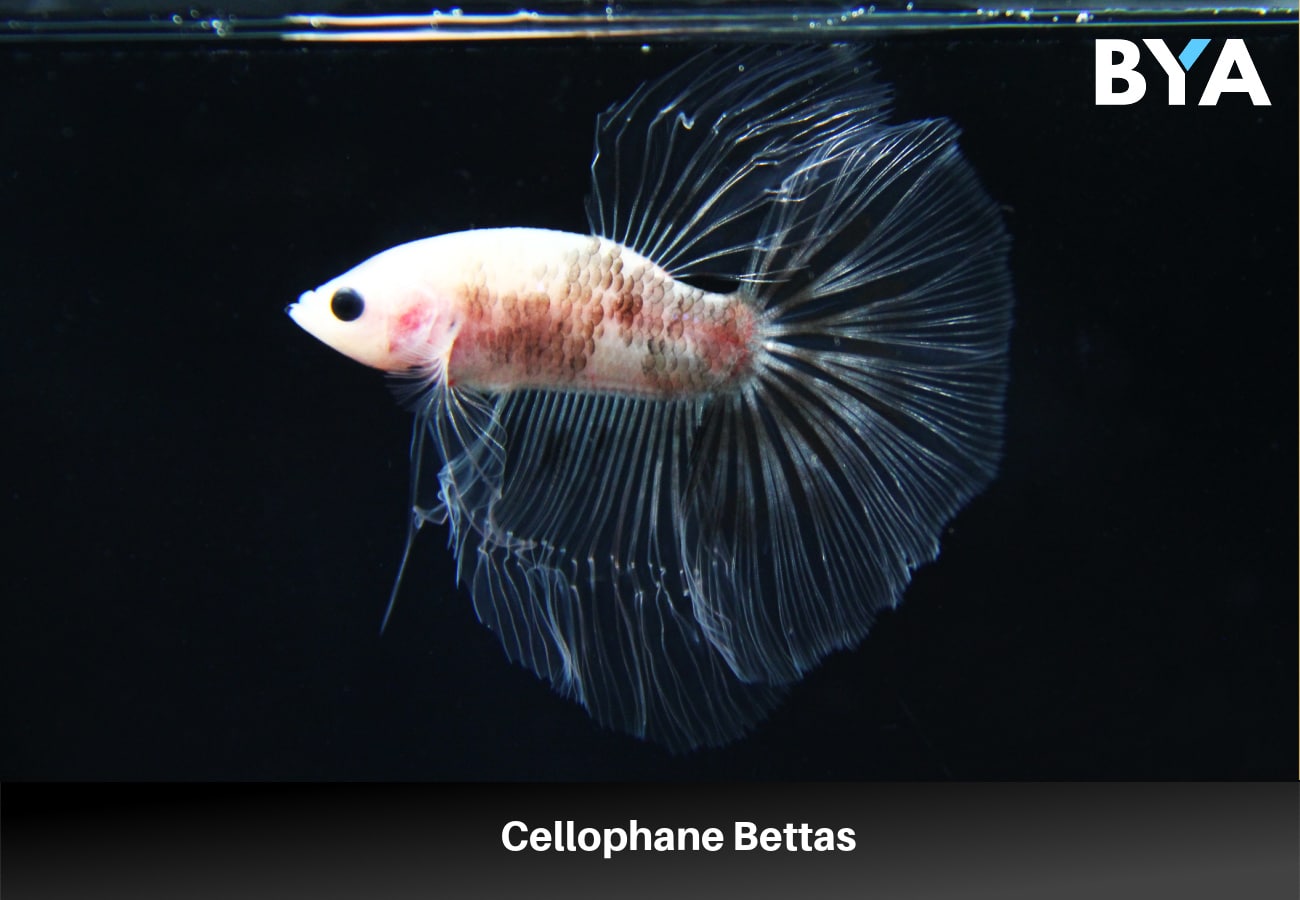
With their translucent skin, cellophane bettas often get overlooked. Most prospective owners hunt for the brightest, most colorful fish. Cellophane bettas are the opposite.
Their bodies and fins are typically a uniform pale pink to white color. They may have some slight marbling.
The fish that appear pinkish get that color from the flesh underneath their skin. The skin itself is clear and has no pigment.
Buyers often confuse these fish for albino bettas, who typically have whiter skin.
Cellophane bettas won’t have the red eyes of the albinos, either. Instead, their eyes are black like all other bettas.
Mustard Gas Bettas

Striking mustard gas bettas have dark bodies and contrasting yellow or orange fins. Their bodies are typically deep blue, green, or blue-gray.
Pastel Bettas
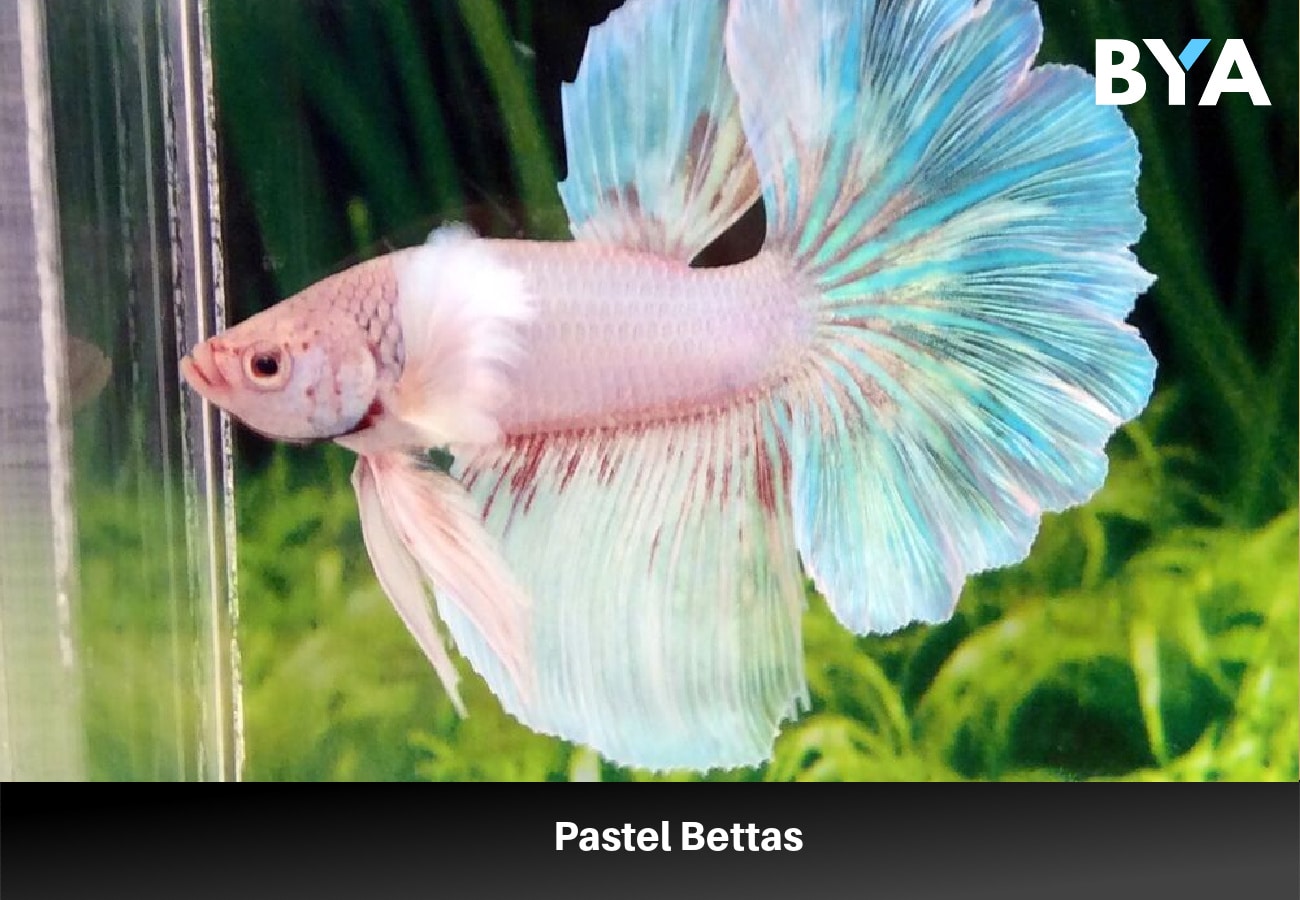
Pastel bettas, also known as opaque bettas, have creamy white bodies. The base of their body is another color, often red or blue, covered by the white scales. The base color peaks through the edges of the creamy white scales.
The coloration of these bettas comes from a specific gene. The gene causes the white color to overshadow the base color.
Yellow/Pineapple Bettas
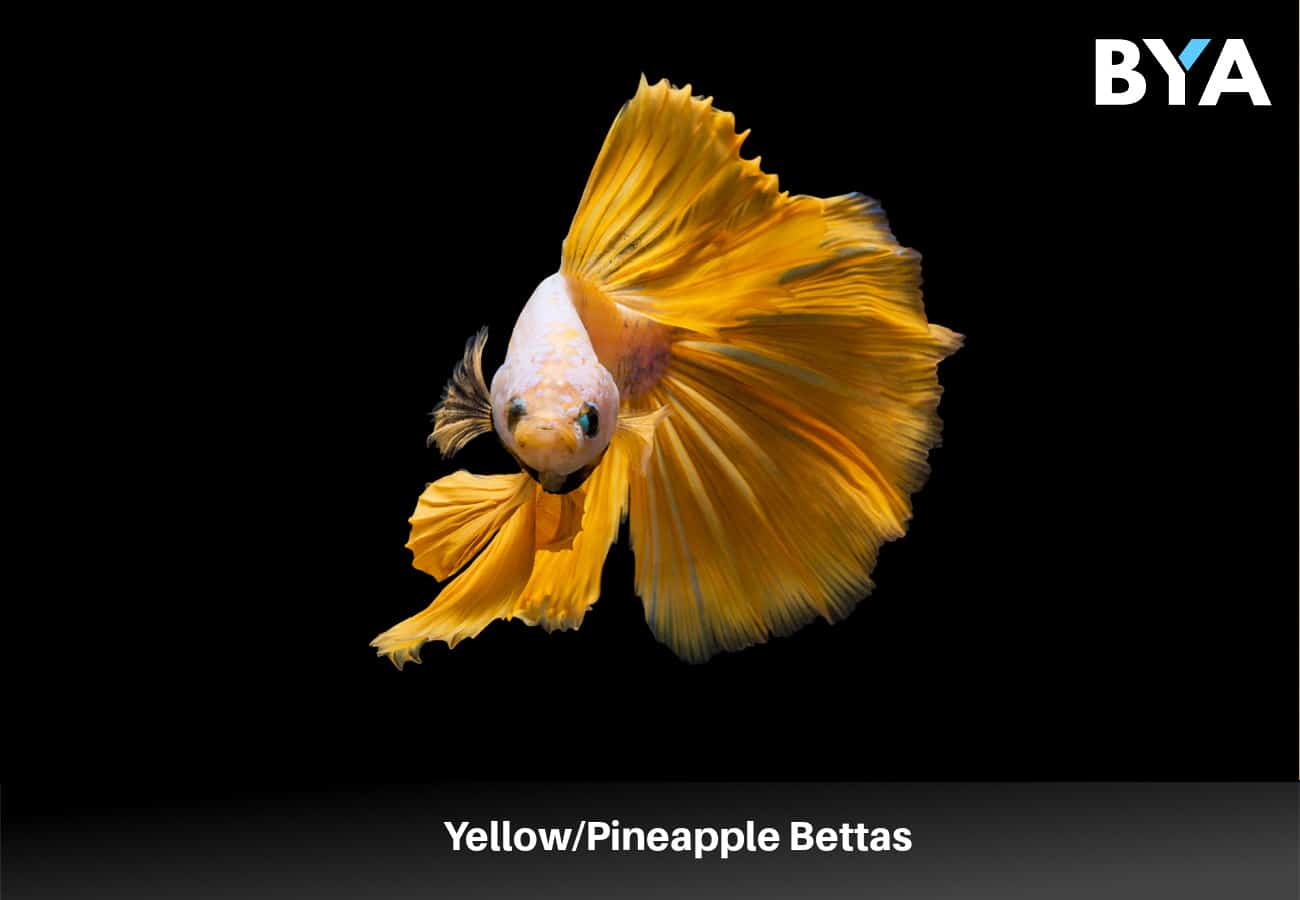
Yellow bettas are common and range from light to bright yellow.
Pineapple bettas are a distinct kind of yellow betta. Their scales are slightly darker around the edges, resembling a pineapple.
Many times, these fish are not labeled as “yellow” bettas. Instead, buyers should look out for fish labeled “non-red” bettas.
Chocolate Bettas
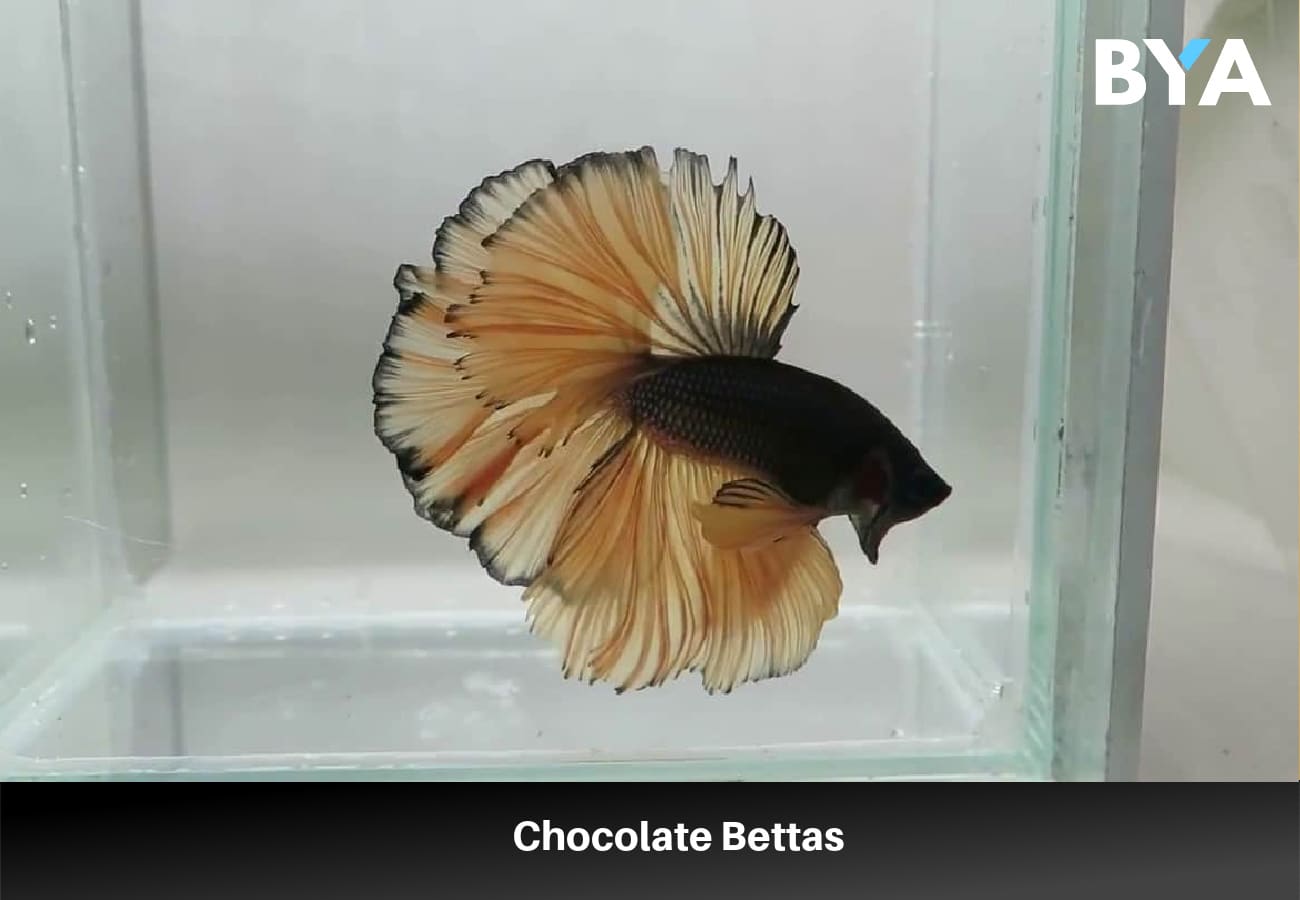
These bettas have brown bodies with translucent yellow fins.
Hobbyists often confuse these bettas with “mustard gas” bettas.
Copper Bettas
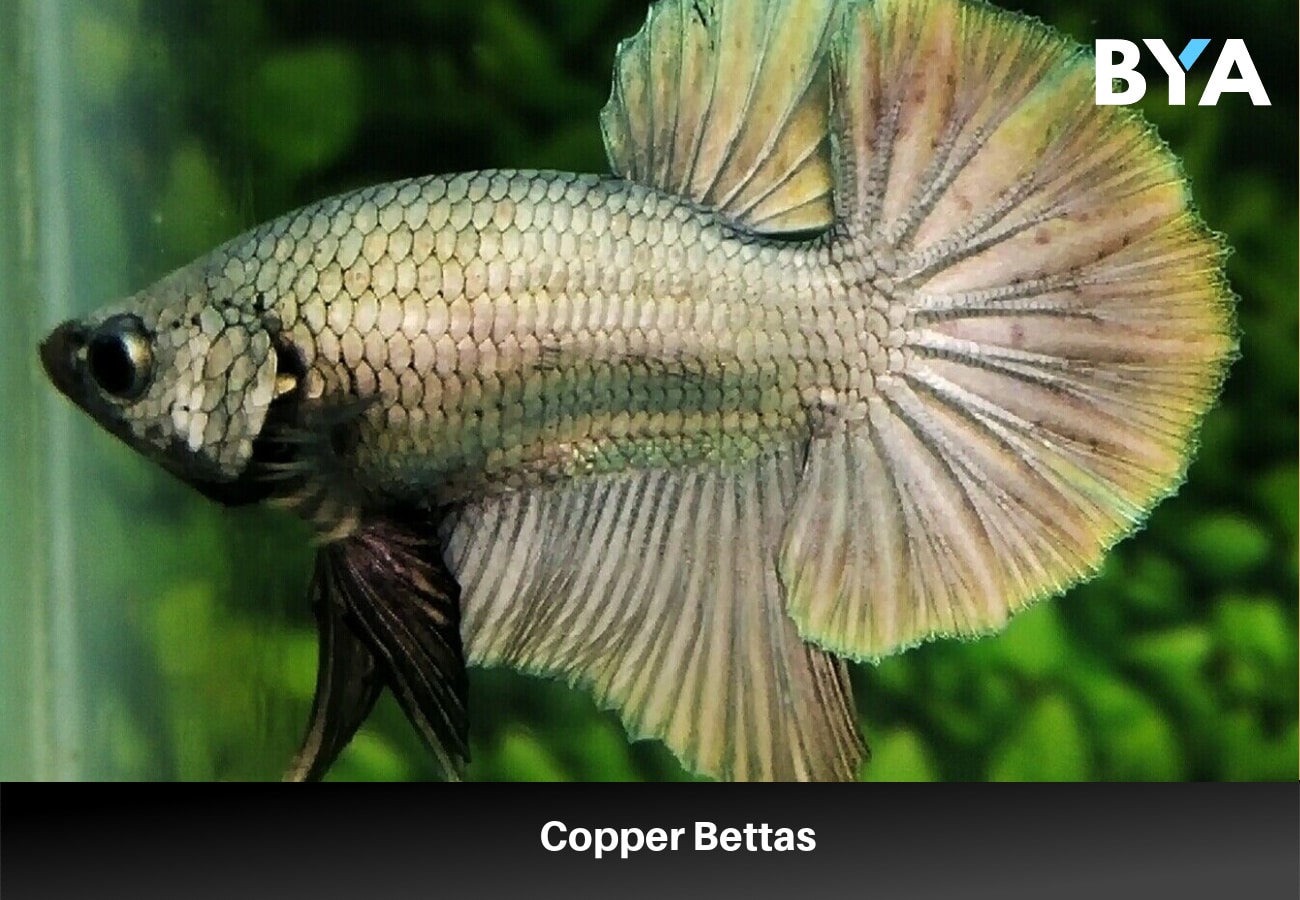
Copper bettas have iridescent skin of copper or gold.
Often, a significant amount of black with the iridescent scales. The black coloring helps the betta’s shininess stand out.
Many times, the scales have a red or blue hue to them.
These fish often look best under strong lights that help highlight their color. Weaker lights make their bodies look silver or brown.
4 Rare Betta Fish Colors
Several colors are rare and are much more expensive than the ones listed above. Hobbyists usually need to buy rare colors directly from breeders. They seldom pop up in regular pet stores.
Albino bettas
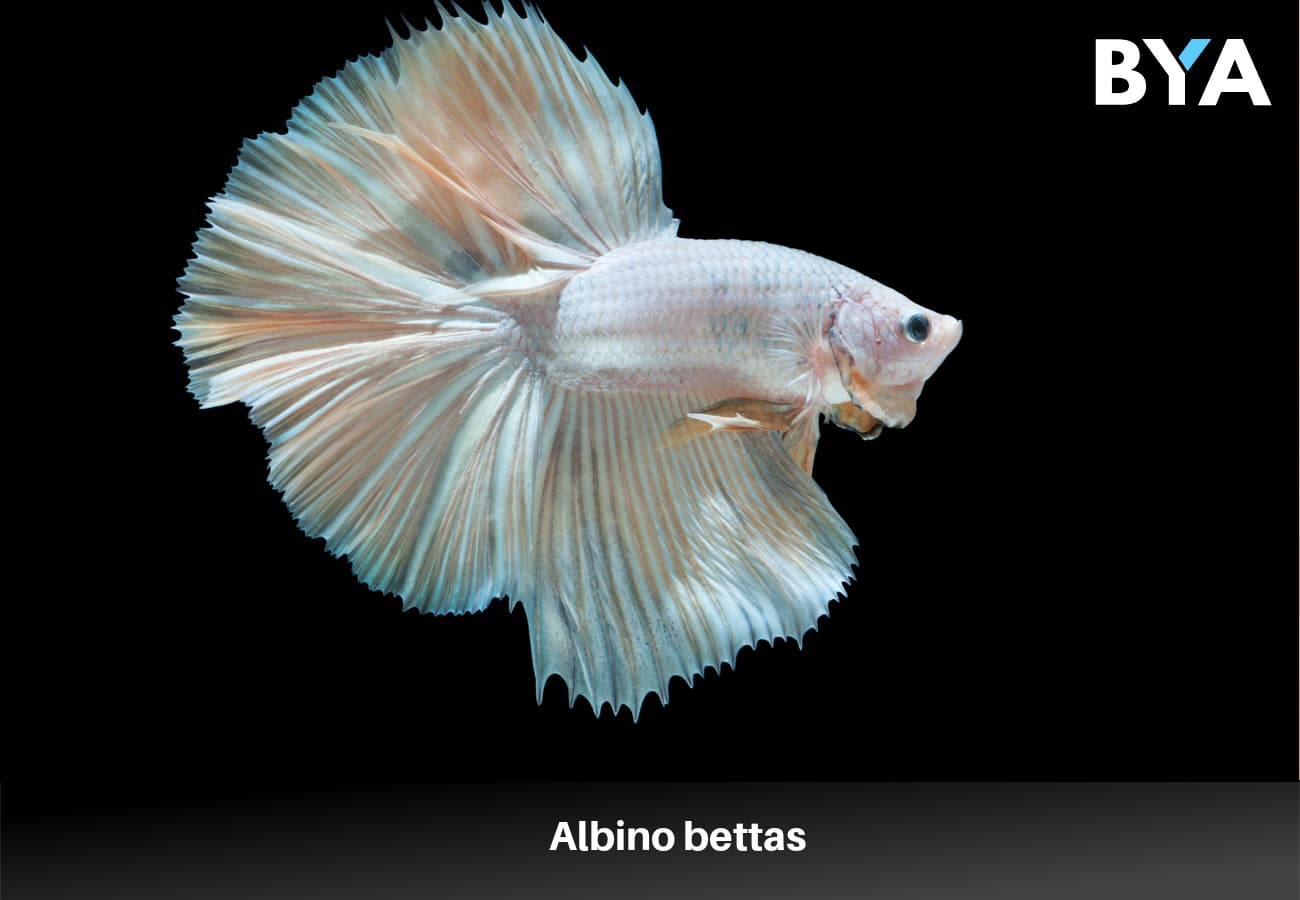
An albino betta is the rarest color of betta fish in the world.
Albino bettas are pinkish white and have red eyes. Their rare appearance actually comes from a lack of color.
Unfortunately, albino bettas tend to have many health problems. Their tendency for poor health is one of the reasons they are rare. It’s also significantly difficult to breed albino bettas.
Purple Bettas
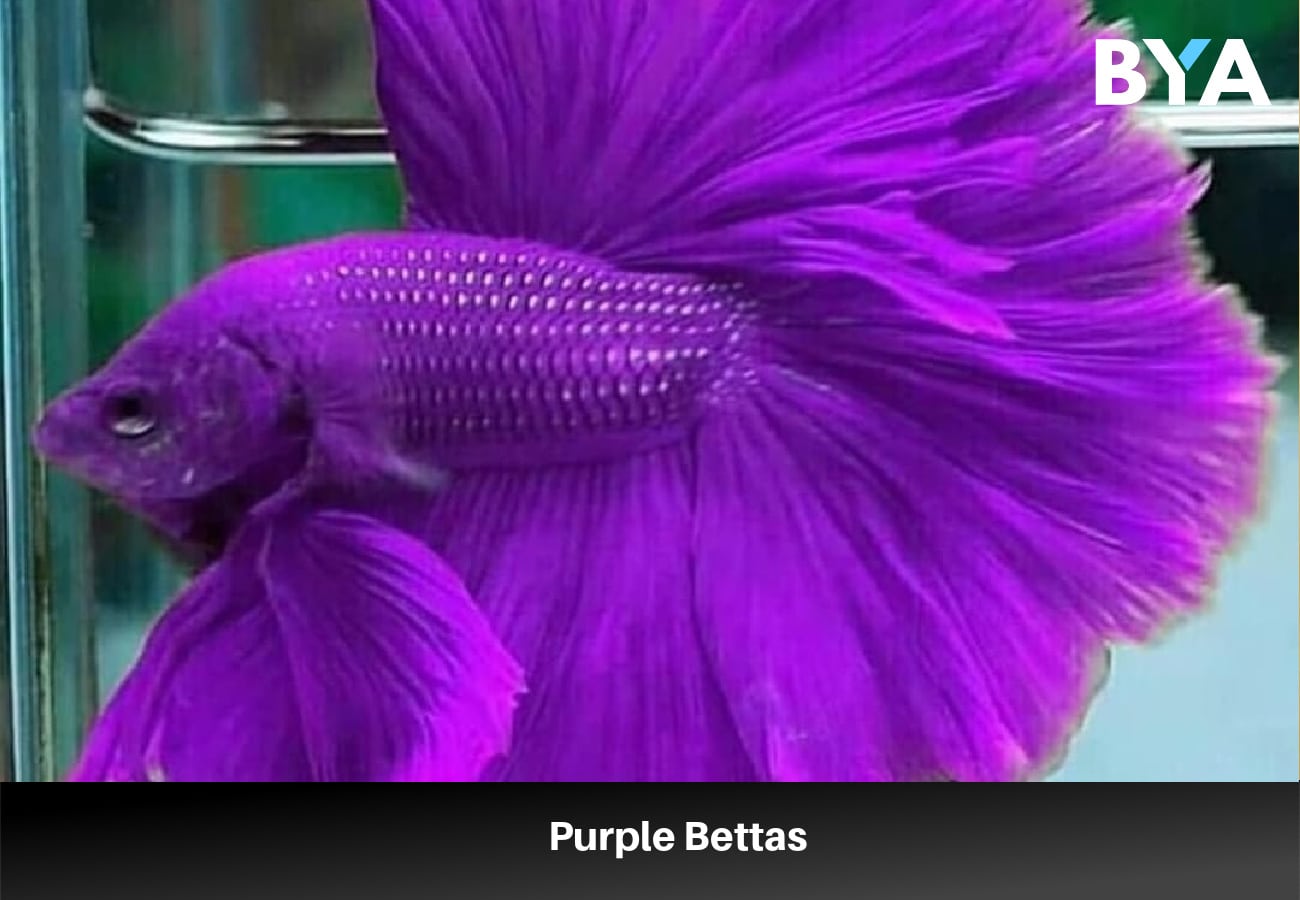
True purple bettas with solid purple bodies and fins are extremely rare.
It’s more common to find copper bettas with violet or purple hues. Other bettas may have solid purple bodies with fins of a different color.
Green Bettas
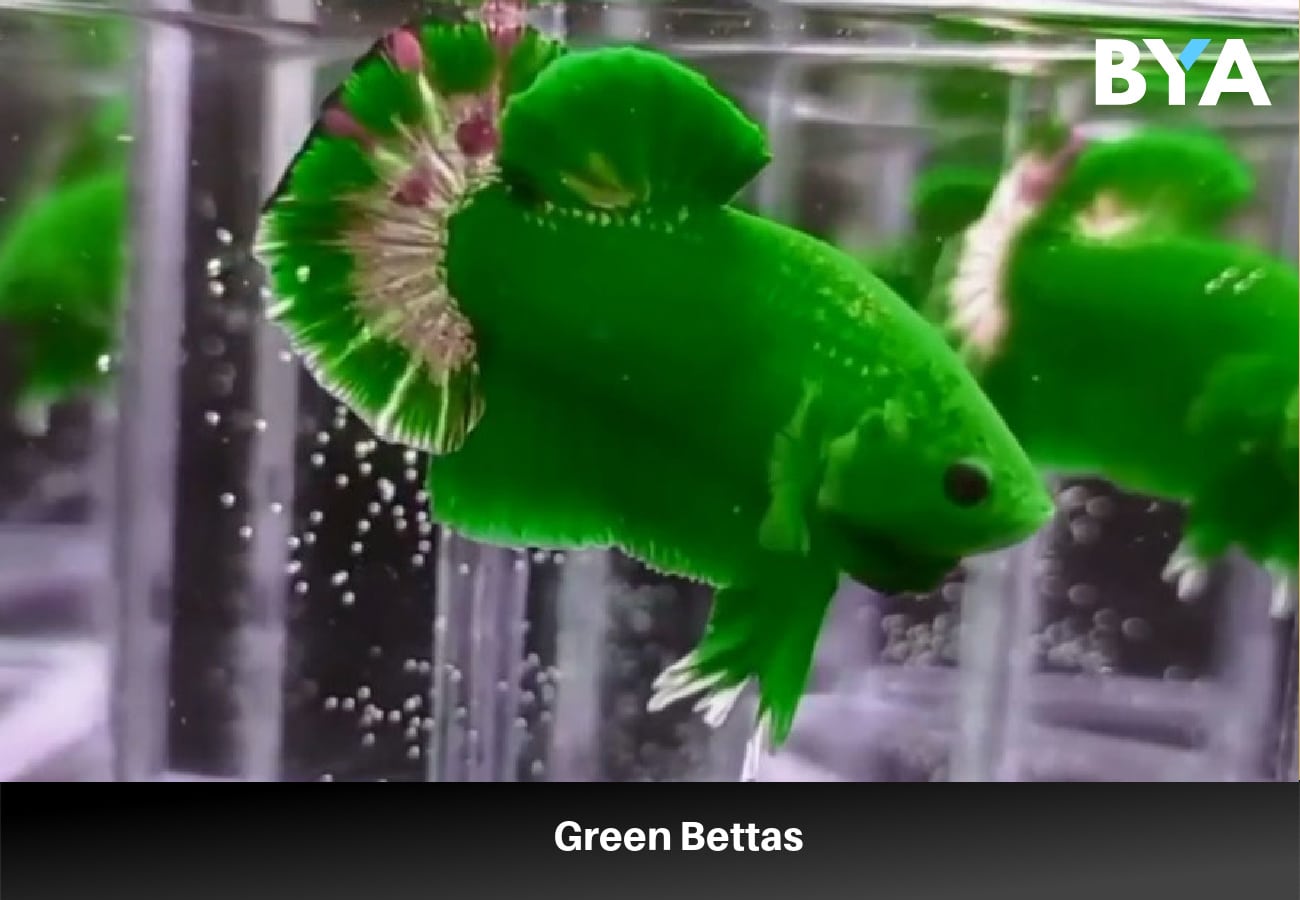
True green bettas are incredibly rare. They are highly prized and sell for a lot of money.
It’s tricky to see green coloration except under high light. Green bettas are often mislabeled; they look brown or blue under regular light.
Most “green” bettas are really turquoise and quite common.
Orange Bettas
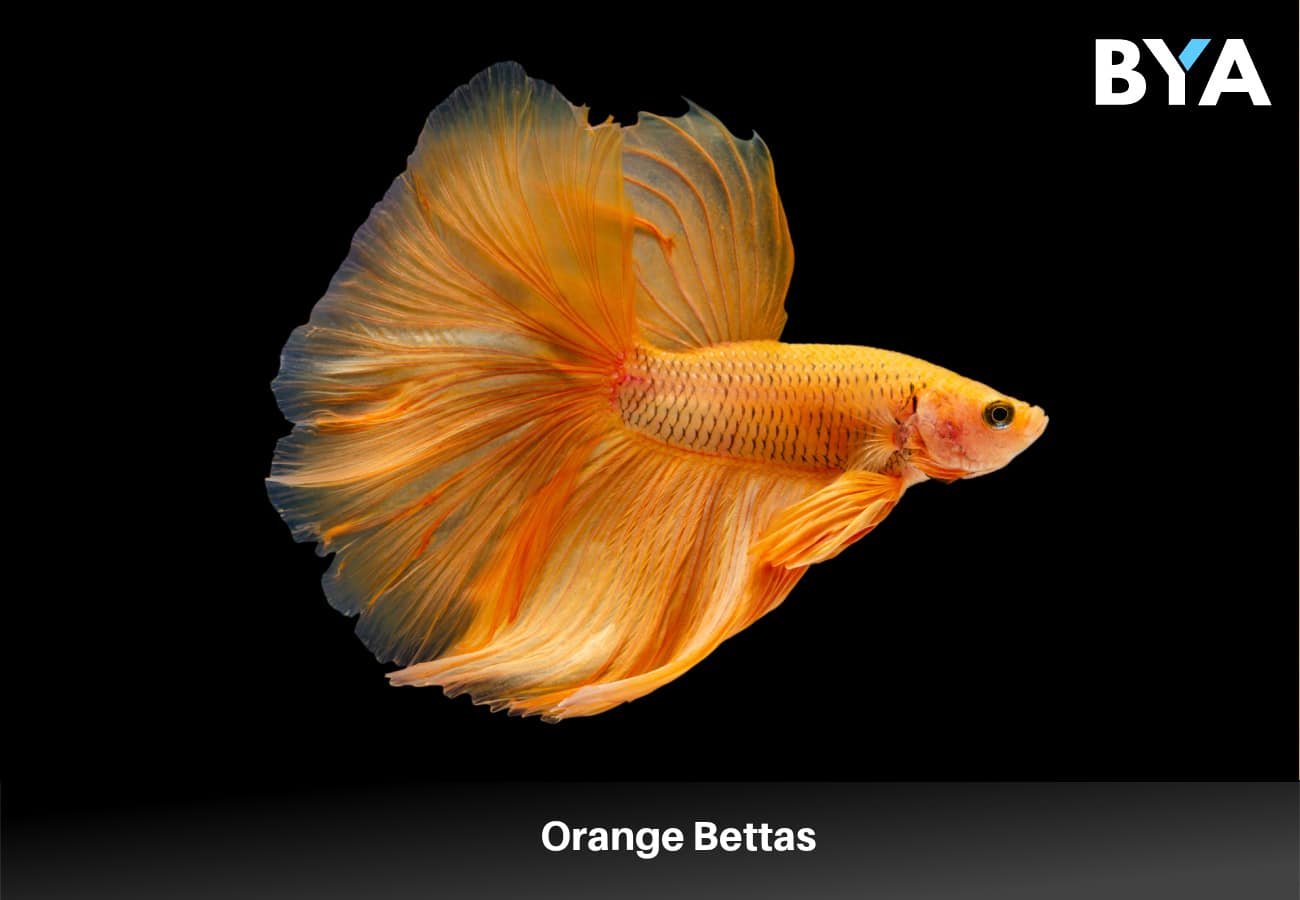
Orange bettas are also rare, though more common than green or purple bettas.
Hobbyists must have strong lighting to bring out the tangerine color of these bettas. In weak lighting, they generally look red.
10 Types Of Betta Fish Patterns
There are many solid-colored bettas, though there are over 10 common types of color patterns.
Solid Bettas
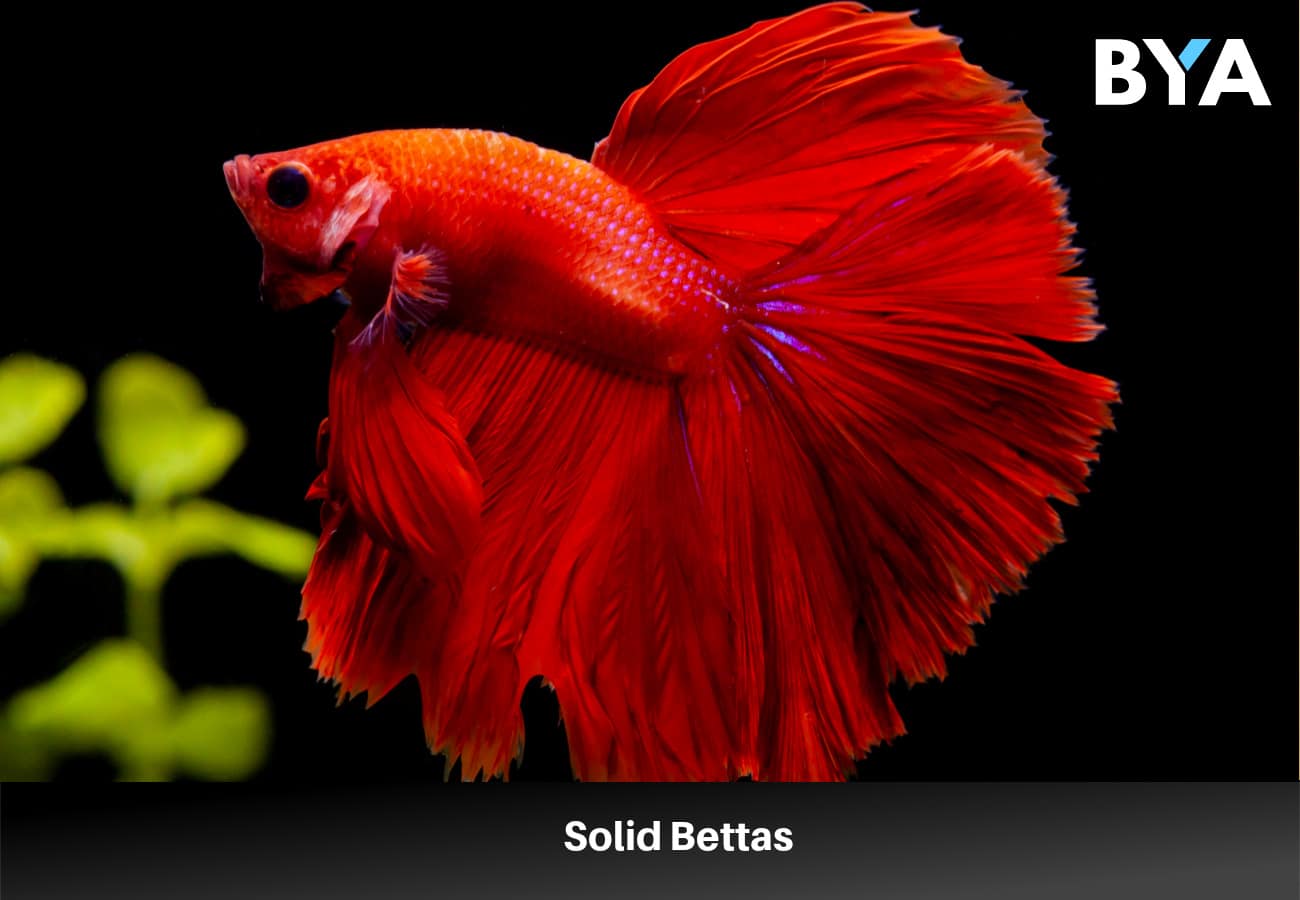
Although not technically a pattern, solid-colored bettas are common. Most solid bettas have red bodies, with blue coming in at a close second.
Multi-Colored Bettas
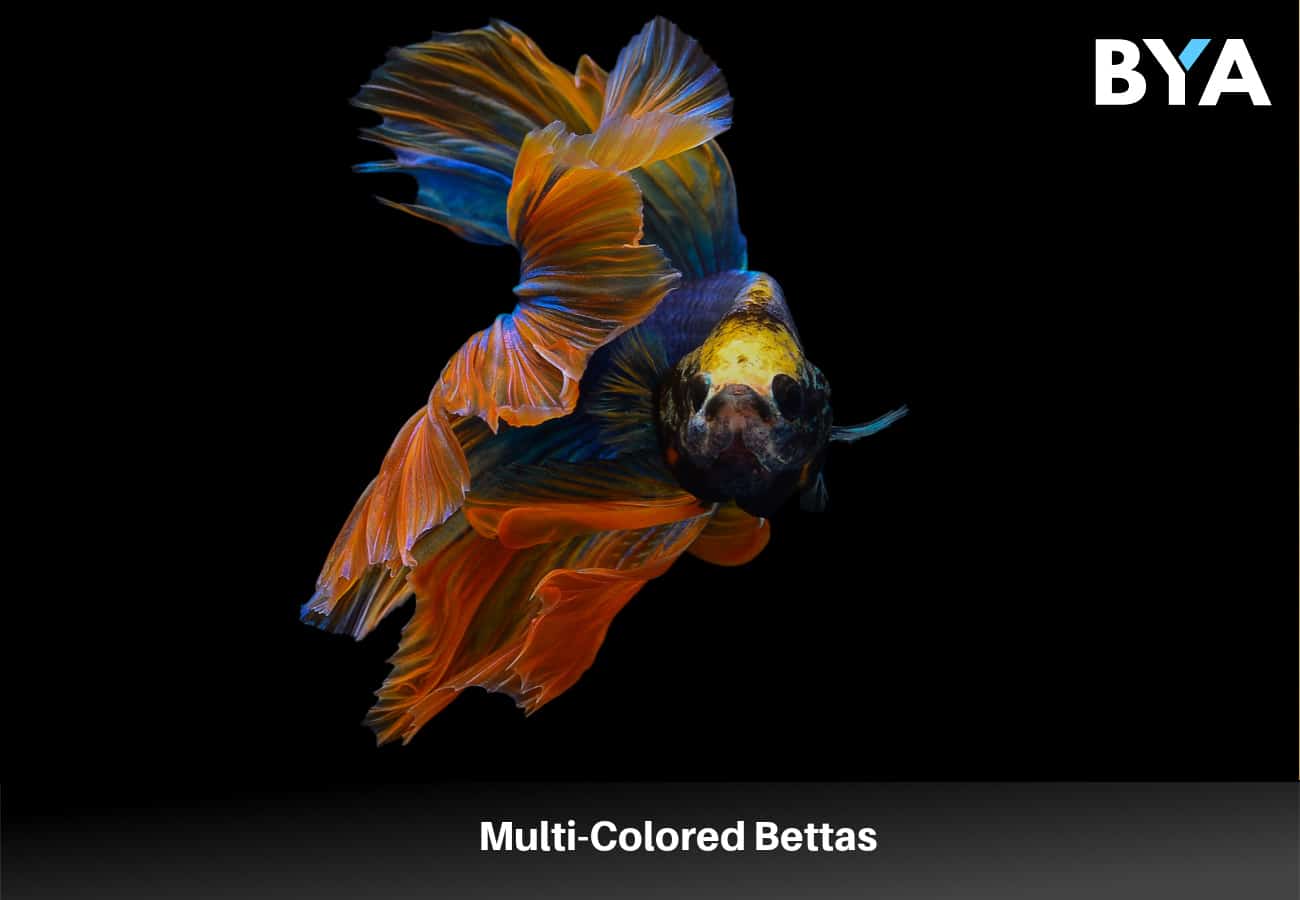
These bettas have three or more colors on their bodies and don’t fit into any other groups on this list.
Bi-Colored Betta
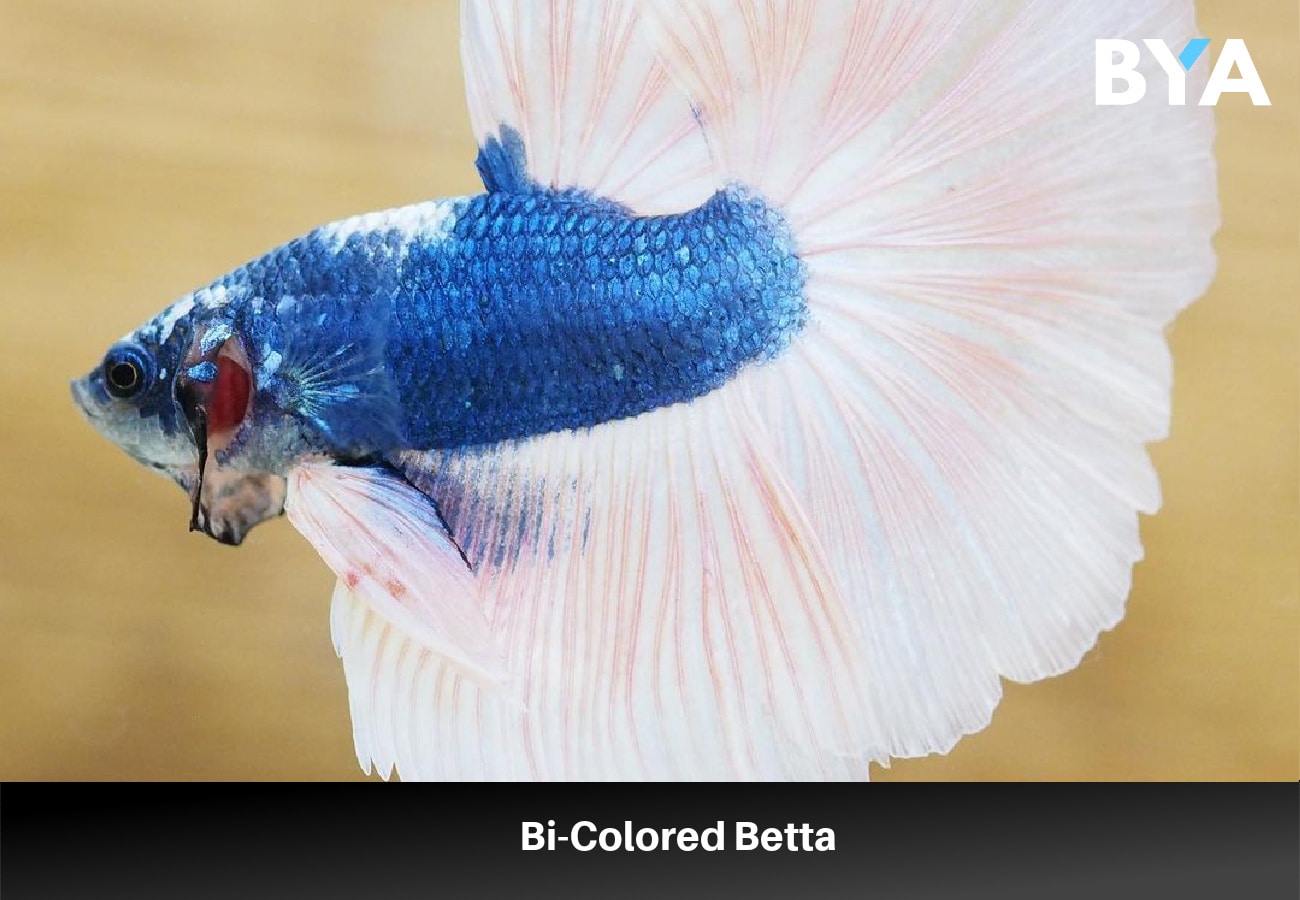
These bettas have a body that is one color and fins that are another. Typically, the two colors contrast to produce bettas with striking bodies.
There are two common types of bi-colored bettas: light and dark.
Light bi-colored bettas have light bodies. Some fish have similarly light fins, though darker fins are more common and popular.
Dark bi-colored bettas have dark, solid-colored bodies. Their fins may be transparent with little color. Their light fins help them blend in with their surroundings. Conversely, their fins may be brightly colored to contrast with their dark bodies.
Some bi-colored bettas have heads that are darker than the rest of their bodies.
Fish that have three or more colors on their bodies do not count as bi-colored bettas.
Butterfly Betta
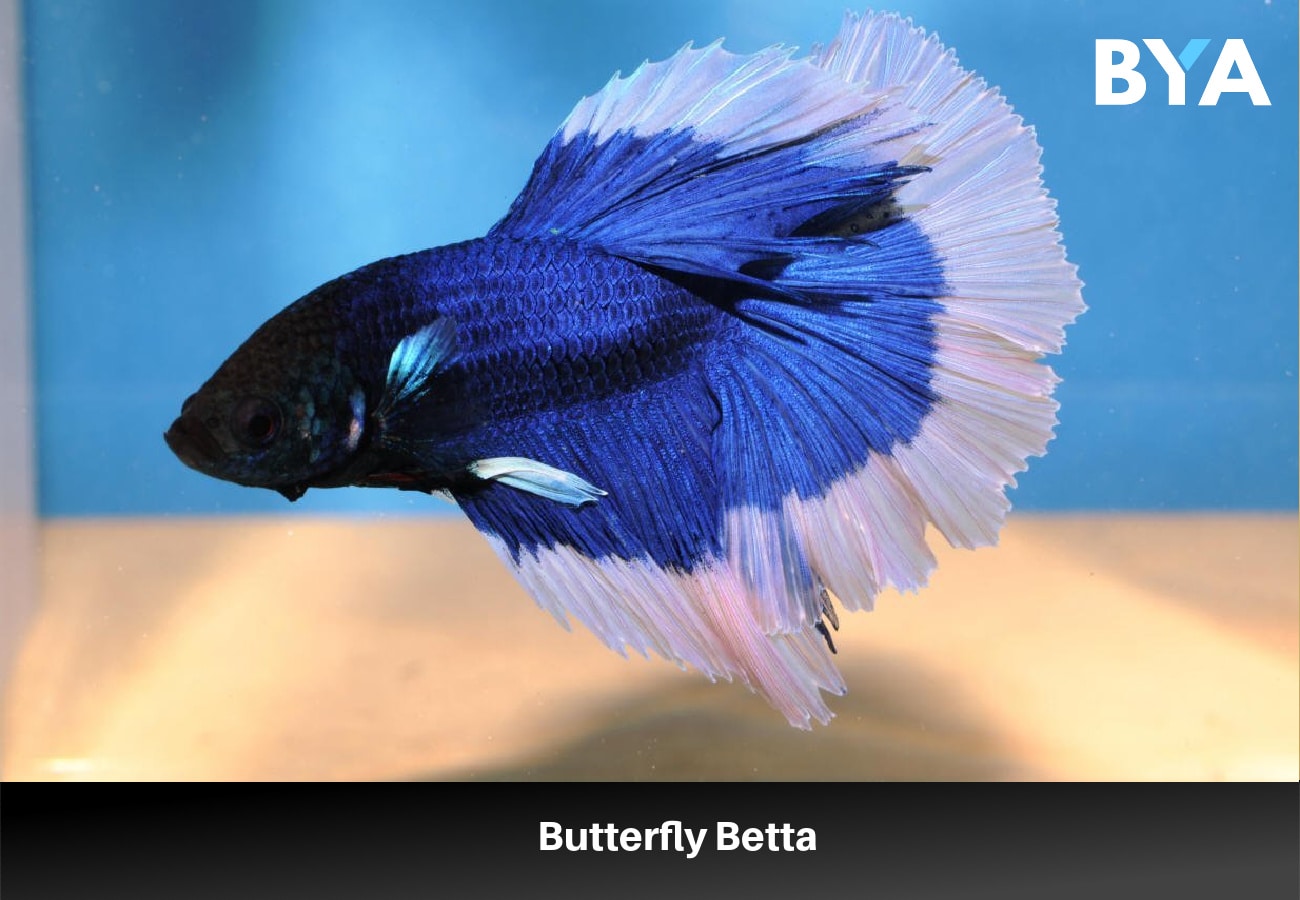
Butterfly bettas have solid-colored bodies. Their body color leaches into the base of their fins. About halfway through their fins, the darker color ends. The other half of their fins are translucent or very lightly colored.
The gentle fade of their color from the body to the tip of the fin gives them a butterfly-like appearance.
Cambodian Betta
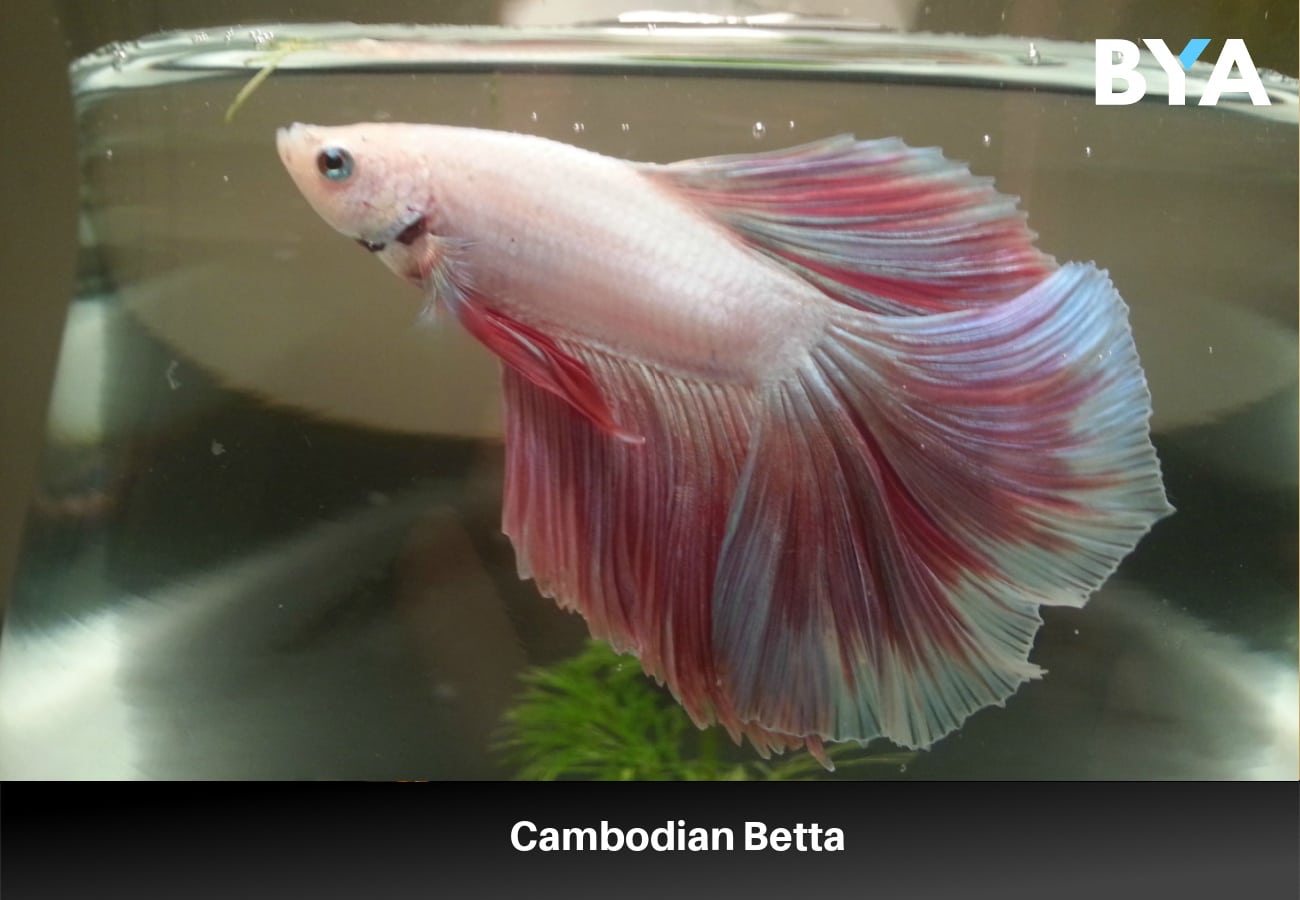
Cambodian bettas have bodies that are a solid, pale pink color. The pink bleeds into the fins in irregular rays. The fins are a darker, brighter color, usually red. The rays make the fins look petal-like.
Cambodian bettas are a variation of the bi-colored betta. Their unique pattern earns them their own name.
The brighter color may extend to the ends of the fins or may stop shortly before the ends. The tips of the fins are often translucent.
Dragonscale Bettas
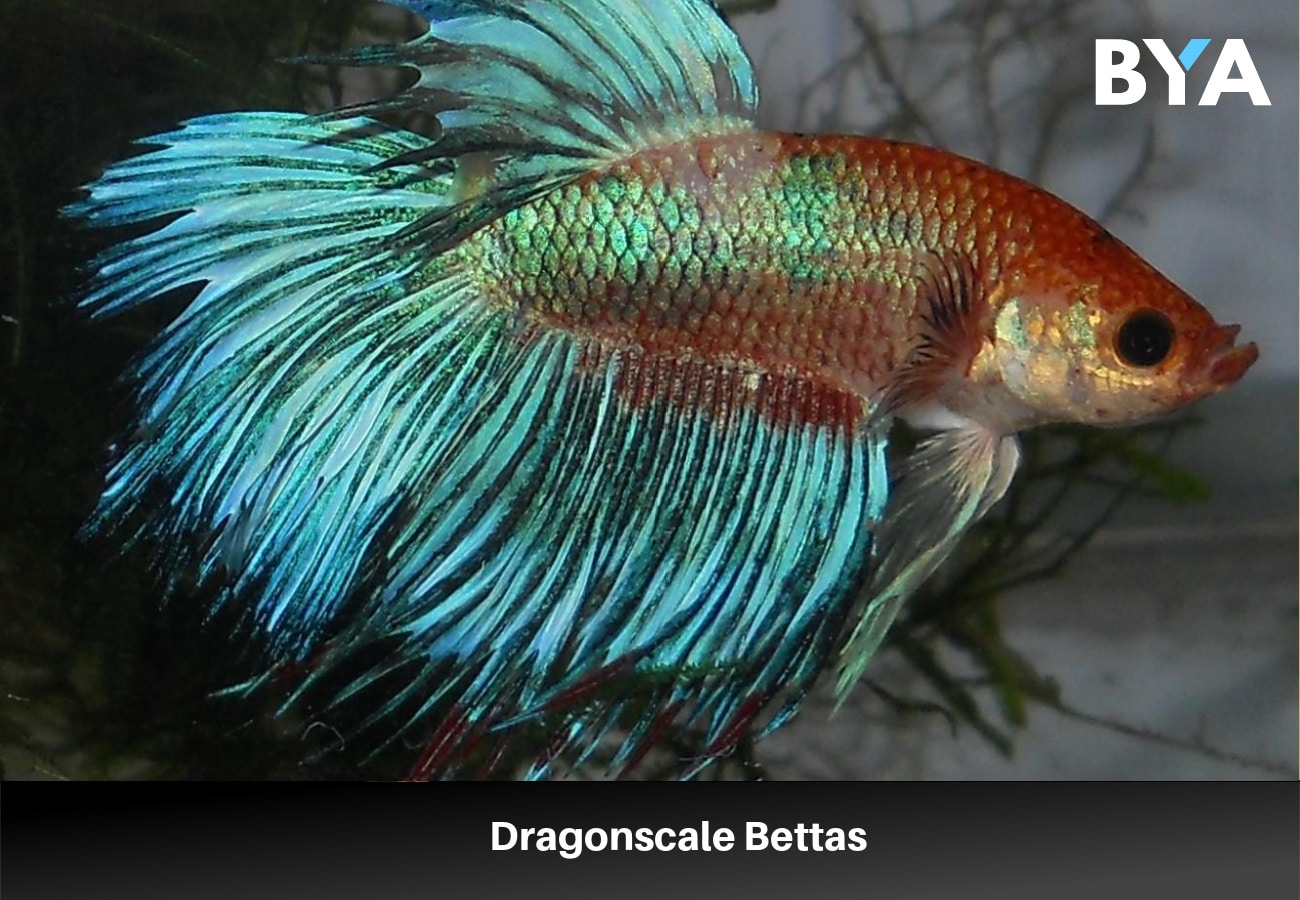
Dragonscale bettas are popular because their colors are metallic-like.
They have a dark base color, usually red, that barely peaks through the scales. The scales are an iridescent, translucent white that shows a hint of the red underneath.
The scales are thicker than that of other bettas. The thick scales give them a dragon-scale-like appearance.
The fins are often the same red color as the base of the fish’s body. Some white may bleed into the fins, though it doesn’t cover the fins like it does the scales. As a result, fish often have white bodies with highly contrasting red fins.
The dragonscale pattern is somewhat new. Unfortunately, these fish seem prone to health issues.
Marble Bettas
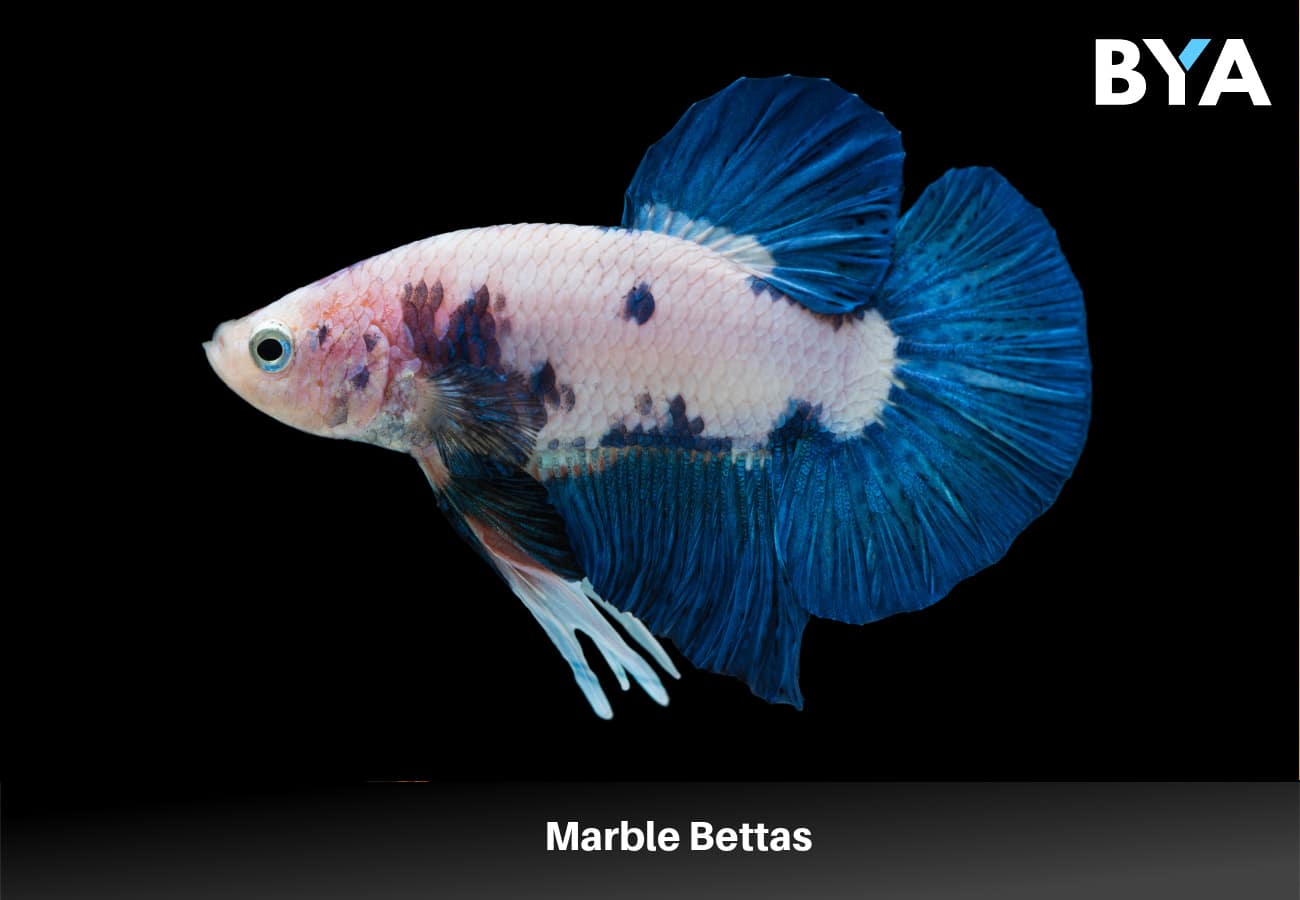
Some bettas have the “marbling” gene. They have light bodies with irregular dark splotches. The fins may have a dark marbling pattern or be translucent.
The “marbling” gene allows these bettas to change color over time.
Sometimes, the blotches may change places or sizes. Other times, the betta may lose most of the splotches and become almost solid in color.
After some time, a marble betta may look much different than when its owner first bought it.
These bettas are sometimes called “koi” bettas. They went through selective breeding to resemble the elegant koi fish that live in ponds.
Marble bettas can continue changing color throughout their lives.
Dalmatian Bettas
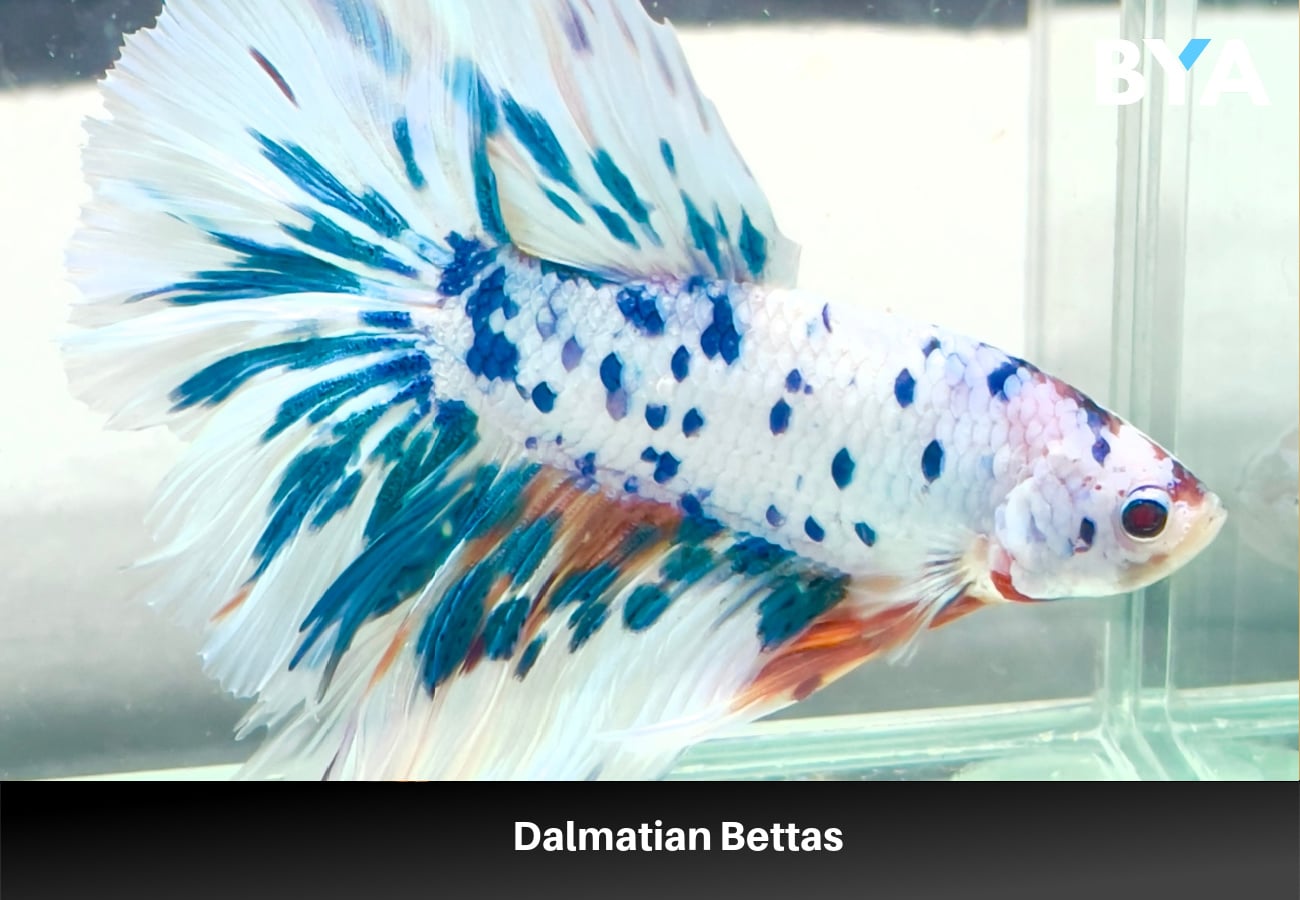
Dalmatian bettas are like marble bettas, though their colors are more pronounced. Their splotches may be blue, white, orange, or red.
The rarest form is the orange dalmatian betta. These fish have light yellowish-orange bodies and fins. Darker orange spots and streaks run along the body and fins.
These bettas also go by “orange-spotted betta” and “apricot-spotted betta.”
Alien Bettas
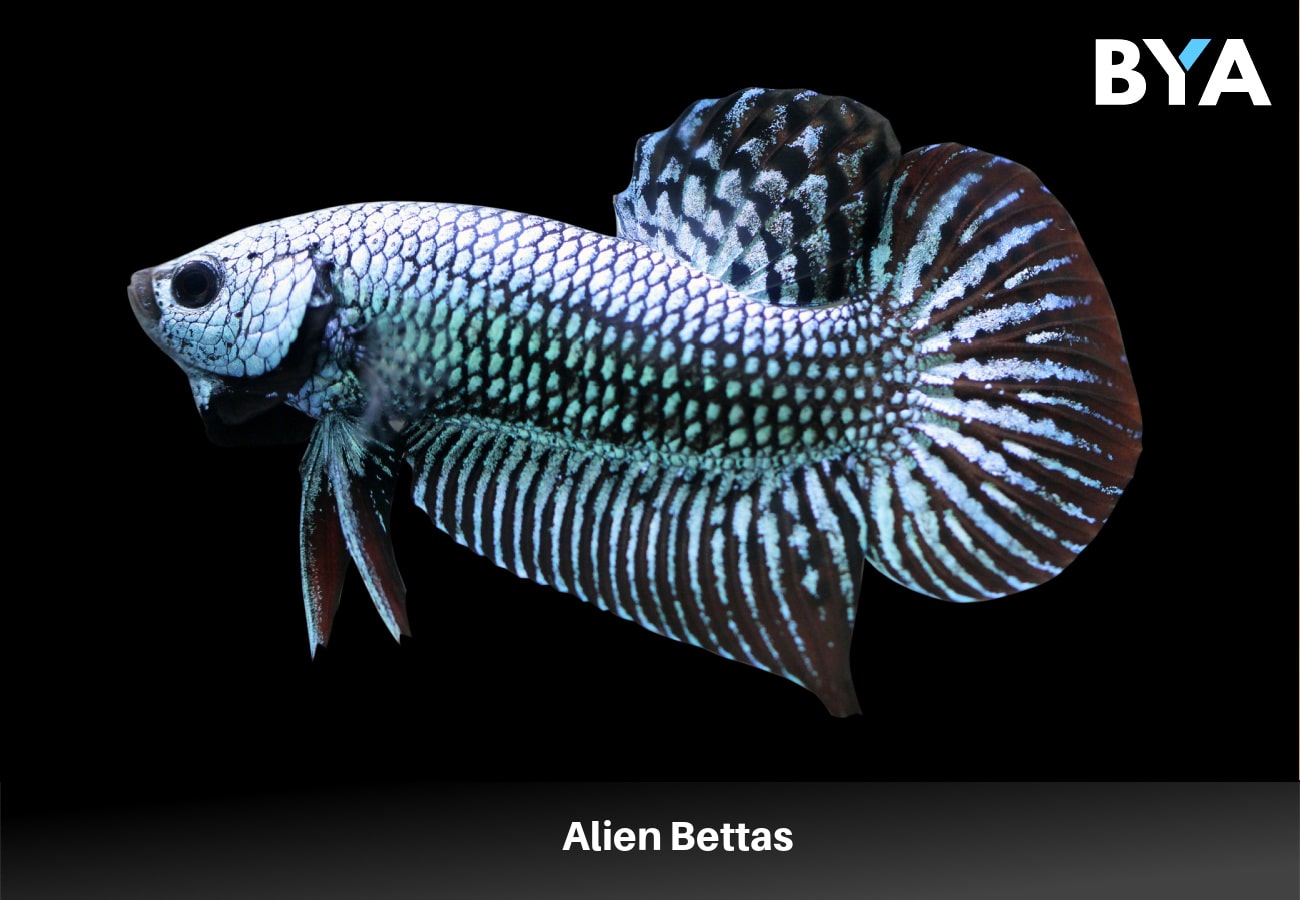
Alien bettas get their name from the dark base color of their bodies covered by a lighter metallic color. Their scales have black edges that help their colors stand out.
An alien betta’s body has a lot of contrast, making it one of the most interesting patterns on the market.
Piebald Bettas
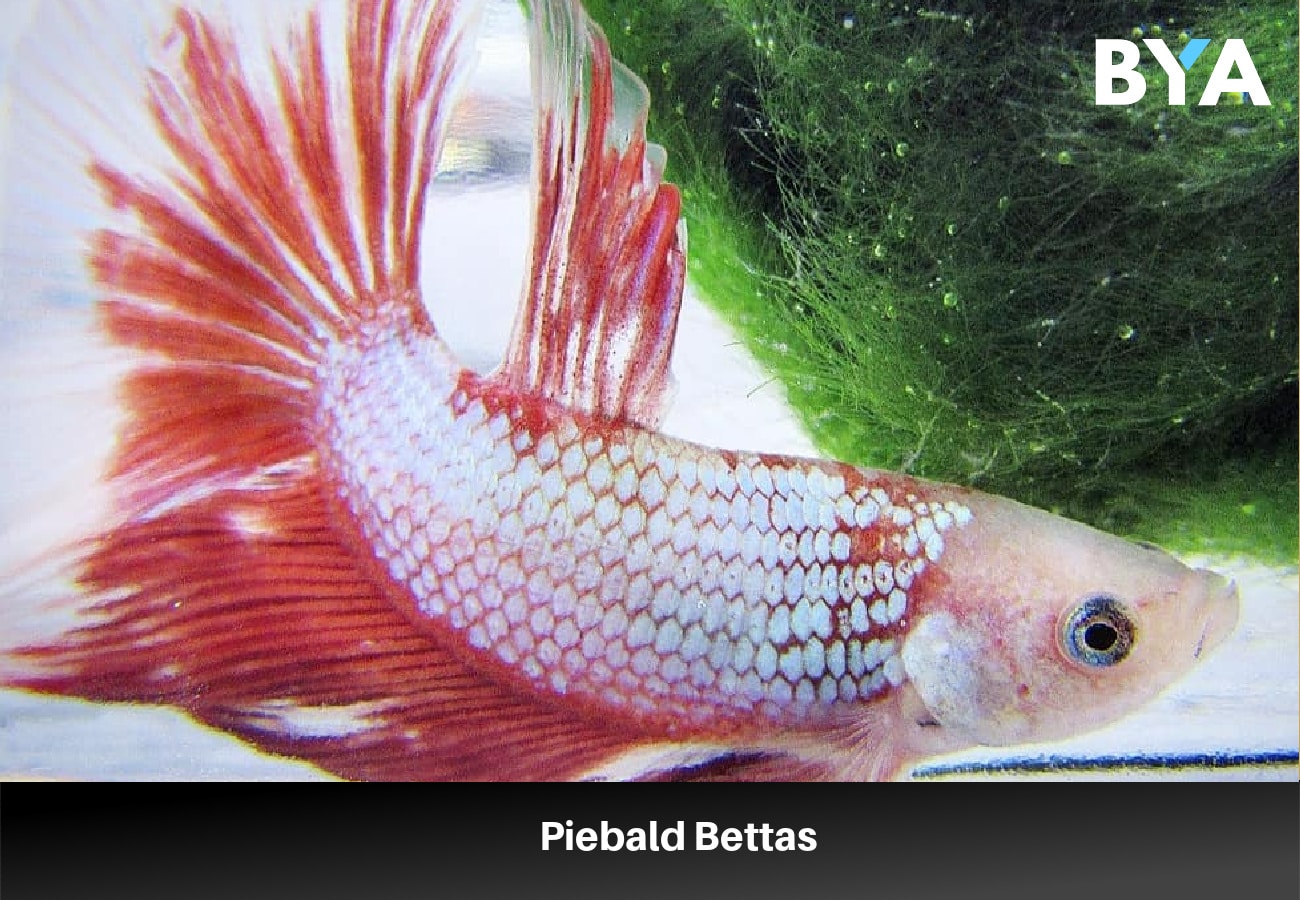
Piebald bettas get their name from their white or flesh-colored faces. The rest of their body is generally a darker color. Some of these fish may have light bodies, like their faces, though this is rare.
Some of these fish may have the marbling gene.
What About Betta Fish Losing Color?
Most often, if a betta begins losing its color, it’s because it’s sick, dying, or experiencing stress.
A brightly-colored and active betta is the prime indicator that the betta is healthy.
Check Your Betta Regularly
Owners should check on their fish regularly to be more likely to notice any changes. If needed, compare old photos of the betta to its current state to see if the fish is getting any paler.
It can be challenging to spot a betta that is losing its color, as the changes can initially be subtle.
Poor Water Quality
Hobbyists that notice their betta’s color fading should test the water. Check if there has been a spike in ammonia, nitrites, or nitrates.
Getting the fish back to health could be as simple as a good cleaning and water change.
Illness Or Injury
Owners should look for signs of illness or injury besides color loss. A sick or injured fish needs treatment right away before the illness worsens.
Stress
Stressful situations can cause loss of color if illness, injury, or poor water quality is not to blame.
Are any of the tank mates bullying the betta? Is the current from the filter too strong? Do they have enough decorations to have a place to hide?
Old Age
A betta that is old and reaching the end of its life will begin losing its color. In these cases, hobbyists can’t do anything except keep their fish comfortable.
The Fish Is New
Keep in mind that new fish often act like sick fish, too. Being placed in a new tank is scary for new fish, and they need time to adjust.
For the first couple of weeks, a new betta may be pale and spend much time hiding. Give them some time to adapt and feel comfortable in their new home.
Can Betta Fish Get Their Color Back?
An unhealthy betta will certainly regain its color once it recovers.
Depending on the cause of the loss of color, some bettas may regain their color in as little as a day. For more severe illnesses or injuries, it may take several weeks or months for a betta to regain its color.
Betta Fish Changing Color
A betta fish that changes color has the marbling gene. Marble fish have splotches of different colors all over their body.
Owners are often confused by their bettas suddenly changing color one day. They may not have heard of the marbling gene or didn’t know their betta had it.
As long as the betta is not becoming paler, a color change is rarely cause for concern.
How To Make Betta Fish More Colorful
Having a good-quality LED light is one of the best ways to make a betta appear more colorful.
The light shouldn’t be too intense, as overly bright lights can cause bettas stress. A nice LED light causes the water to shimmer and brings out the natural colors of the betta’s skin.
Choose A Complementary Substrate & Background
Another way to bring out their color is to choose a contrasting substrate or background.
Keep The Tank Clean & Safe
Keep the betta healthy to help them maintain their best colors.
Keeping the tank clean and the water parameters safe will help keep a betta healthy and active. The healthier and happier they are, the more their colors will stand out.
Feed Them Healthy Foods
Providing a betta with a healthy variety of food is enough to bring out its colors.
Provide them with betta pellets or flakes made especially for bettas.
Switch out those foods with live, frozen (thawed), or freeze-dried foods periodically. Brine shrimp, bloodworms, daphnia, and mosquito larvae are good options.
Foods high in carotenoids are great at bringing out reds, oranges, and yellows.
Some betta foods and pellets claim to bring out the fish’s color. They contain ingredients that they say make the betta’s colors brighter.
Betta Fish Names By Color
Many betta fish owners, especially children, enjoy naming their fish after their colors. There are many colorful betta fish names; we’ll only review a few here.
Red betta fish names:
- Blaze
- Auburn
- Cherry
Blue betta fish names:
- Berry
- Indigo
- Sky
Black betta fish names:
- Thunder
- Midnight
- Molasses
Yellow betta fish names:
- Buttercup
- Mango
- Sunny
FAQs
What Color Light Do Betta Fish Like?
Betta fish prefer soft white or blue lights for their aquariums. They like somewhat dim environments and may become stressed by a too-bright light.
In the wild, bettas live in waters full of aquatic vegetation. The abundance of plants obstructs the light coming from above. Due to the plants, they live in a murky environment.
Blue light is said to be calming and is a good choice for bettas. It’s more challenging to see their colors in blue than white light.
Red lights are controversial. Some owners say red lights calm their bettas. Others say it makes them overstimulated.
Do Betta Fish Lose Their Color When They Die?
Betta fish lose their color when they die and/or when they are about to die. Many bettas appear whitish-gray after death.
Can Betta Fish See Color?
Bettas have excellent color vision and can see over 300 different colors.
One of their primary triggers is bright colors in other fish. They see colors as a threat and are more likely to attack.
Bettas perceive color differently than humans since they live in water.
Bettas can also see shapes really well, though they are nearsighted.
What Is The Best Color Gravel For Betta Fish?
The best color gravel for a betta fish is whichever makes its color stand out more.
Darker gravels are best for brightly-colored bettas. Those with red or yellow skin look nice against dark gravel.
Darker-colored bettas — black, brown, or blue — look best against bright gravels. Red, pink, yellow, green, and other colorful gravels help them stand out.
